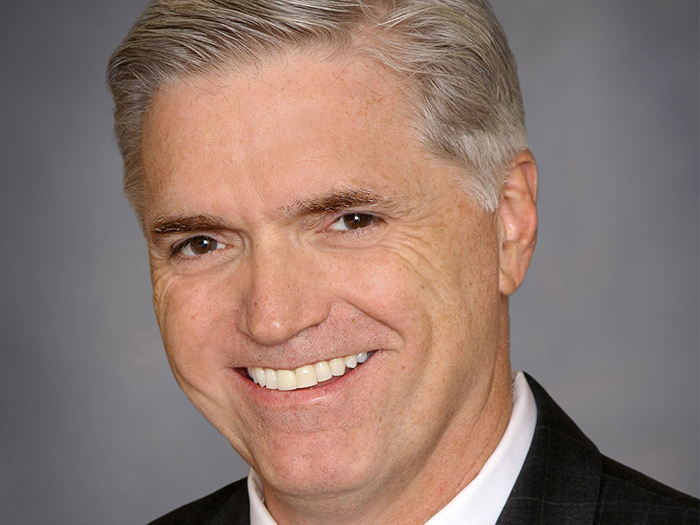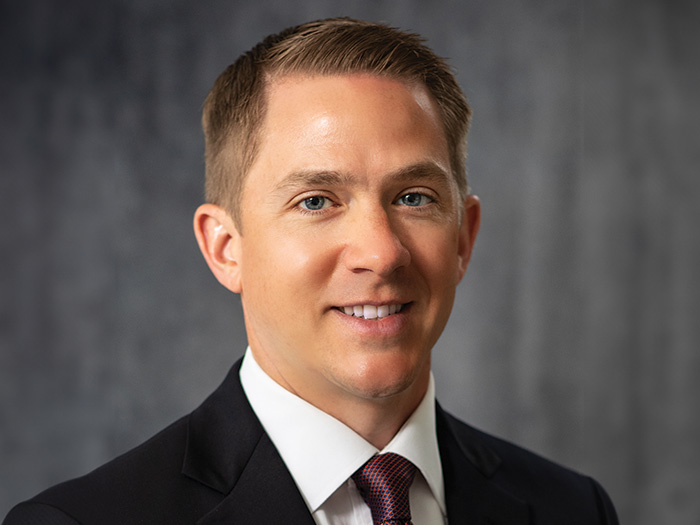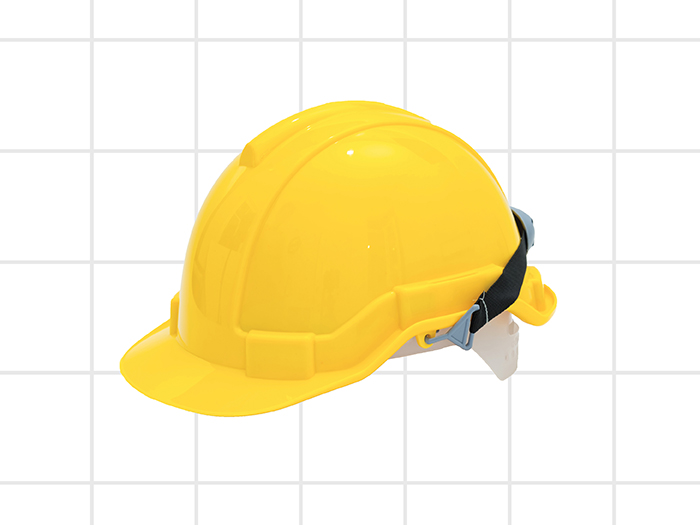12 Questions for The Institutes’ Pete Miller

In December of 2019, The Institutes, a nonprofit insurance industry thought leadership and education organization, closed on its acquisition of Risk & Insurance®.
From that partnership, the team at R&I has been able to continue to bring readers valuable insight, news and more to our audience, including this one-on-one with Pete Miller, the CEO of The Institutes, to get his take on how the organization has navigated not only the pandemic but a series of eye-catching insurance industry affiliations.
Risk & Insurance: For starters, can you give us your take on how The Institutes navigated the challenges of the pandemic shutdown?
Pete Miller: I work with a great group of people. I think we executed very well, given what transpired. It was an extended time. We didn’t know how long it was going to go on.
There were a pretty severe set of problems that we ran into rapidly. In short order, we changed a lot of our business practices, and in a couple cases, our business model. So yes, we did very well [and] … we’ve seen our way through.
It’s been very tough, but I think to stay focused on serving the customer was what we were trying to do. Most people would probably say it was a pretty hard time.
R&I: When the shutdown first happened, what were the most pressing challenges?
PM: A big chunk of our business is giving exams. We had proctored exams at a physical location, so we were immediately looking at no exams and no exams for an extended period of time. Our assessments folks were able to come up with a way to test over the internet. It was a secure method we were happy with.
The second thing was the elimination of all face-to-face meetings, and that was a big problem and a big hurdle because that’s a significant part of the way we serve our customers and the industry.
Immediately we were looking at a massive inability to serve customers, and therefore a massive loss of revenue. We had to come up with a way of turning those meetings into virtual meetings, and we had a great group of people do that. We tested six or seven different ways of doing that, and we were able to come up with a method that worked.
There were other issues, but those were the two biggest. Then there are the knock-on effects of that, like contracts for hotels we had to renegotiate. So, it was a significant challenge right out of the gate.
The second thing here is you want to play chess. You want to make sure you come out better than you went in. You not only want to meet your immediate needs and your customers’ needs, but you also want to always be thinking about how we can adapt these changes even further to advance our business model.
For example, with the examinations, that turned out to be a real Godsend, because our customers liked taking them online better.
In a situation such as the shutdown, you are faced with the tyranny of the immediate. As in, “I’ve got to fix this right now,” but you’ve always got to think on two levels and go, “Well, let me fix this in the context of a bigger change or strategy that I’m trying to execute,” and that’s hard to do when things are coming at you fast and furious.
R&I: Having the perspective of being 28 months down the road, how do you view the whole experience?
PM: The primary thing is the importance of people. We’ve got a great group of people and that makes all the difference. We work very hard on culture, and we were able to leverage that culture. If I had to say what the number one thing was, [culture] paid off because we had solutions.
I hope, and I believe, people feel they can bring up ideas and go, “Hey, this is the problem. I can fix it right now because I understand what The Institutes is trying to do, and I feel safe making this suggestion.”
We can accomplish what we do, because we have great people. All of us make up the culture. That was, for us, the number one thing we were able to use to generate a lot of ideas, a lot of solutions from a lot of people, because that’s what we hoped that they would do.
R&I: That piece about being able to speak up and put an idea forward is really important. Is it not?
PM: It’s crucial on so many levels, because who doesn’t want to be heard? That creates a lot of engagement, and our engagement scores really reflect that. But also, you get a lot of good ideas.
The people closest to the customers have the best ideas, and the more ideas we can get, the better off we are. They know and they’re the ones talking to customers all the time, and they go, “Hey, this might work.” And even if it doesn’t work, it would give you more information to make better decisions, so I think that’s extremely important.
R&I: In the past few years, the Institutes has forged affiliations with the Insurance Information Institute, the Claims and Litigation Management Alliance, Insurance Thought Leadership and other organizations in addition to its acquisition of Risk & Insurance and its National Comp and National Ergonomics conferences. Could you share the The Institutes’ strategies and goals in making these acquisitions?
PM: At a high level, we’re trying to be the premier knowledge provider for people interested in risk management and insurance. There are two components to that.
Number one, you have content. We need to have world class content and I think we do. The second is, can you deliver it? So, if we say, “We need to have premier content, either create it ourselves or buy it, or buy access to it,” and then a lot of what we’ve done is, well, how do we deliver this? Different acquisitions give us different capabilities to meet the knowledge needs of people in risk management and insurance. So, for example, a magazine. That’s a way of delivering up-to-date topics.
You can also get knowledge through an association, through networking of an association of peers. You can get background knowledge through a designation. Another example is podcasts or webinars.
So, a lot of what we’ve done is tried to say, “We’re going to need access to either markets or capabilities, and if we’re going to be a knowledge provider, let’s get access to develop and to deliver premier content to different pieces of the industry in different ways.” What we want to do is be able to deliver content in a time, manner and place of our customers’ choosing.
We’re thinking about how people acquire knowledge on an everyday basis. There’s a variety of different ways, and we’re trying to make sure there are no barriers to people being able to do that.
R&I: What’s impressed you about the talent pool that you lead as you look at what’s been accomplished in recent years?
PM: Creativeness and the willingness to take a risk.
Given sufficient time and money, you can solve a technical problem or a financial problem, but what you really need is great people, and you need to create an environment where they can develop their skills and develop themselves as far as they can. And if you do that, then that’s a great thing.
Our people showed a keen awareness of what we were trying to do. Then we were able to say, “Well given these conditions, the conditions of the pandemic, here’s how we can adjust the way we build things or deliver knowledge in order to meet the objective.”
That was very impressive to me, because we got a flood of ideas, and it was great. You always hope that’s going to happen, but I think with people knowing what we’re trying to accomplish and then being able to say, and feeling free enough to say, “If we run into this roadblock, here’s now we’re going to solve it. Or here’s what we think we should do to solve it.” It’s just a great group of creative people.
R&I: As you and the board look to the future, what are the must dos and the goals leadership feels are important to achieve?
PM: I use the Wayne Gretzky philosophy: You want to pass the puck to where they’re going to be, not where they are.
The most important thing to me is people. In terms of the industry, do we have a clear sense of the future of risk management and insurance? I spent a lot of time at a recent board meeting talking to our board about where we think risk management and insurance is going. Because our job is to meet knowledge needs not only today but anticipate what skills and knowledge people are going to need, and then proactively get that out there.
It’s really important we’re aligned with where risk management and insurance is going. And then secondly, a lot of what we do is technology-based, information technology, we’re delivering information, so do we have the right skills? Are we a team with the right technologies that are needed to deliver those?
Fortunately, we have a great group of leaders on our board who are very influential, and they’re extremely helpful. We can bounce ideas off them, and they’ll give us a pretty good gauge on where they think risk management and insurance is headed. So, we have to be aligned today and into the future, and then have the capability we need to deliver.
R&I: You mentioned some of the challenges. I like that phrase, the tyranny of the immediate as it related to the pandemic, but going forward and thinking about the goals you and the board have, what do you see as the biggest challenges to achieving those goals?
PM: The focus is going to be on people and thinking about technology. Do we have the right technology in place? Not only that, do we have the right environment for our people to be able to be creative?
We also have to continue to make sure we’re meeting customer needs. I think that’s super important. But if you get the right set of people in the right culture, you can do almost anything. If we have those things, we know in which direction we should be headed, and people buy into what we’re trying to do, then I think we’re in pretty good shape.
R&I: What’s your leadership style and what do you think your leadership traits are?
PM: Well, I hope I’m a good listener, and I hope I’m open to new ideas, because what I’ve found is that any leader who thinks they have all the ideas is sorely mistaken.
So, you’ve got to be a good listener. I’m a big believer in the contingency theory of management, or leadership, which is it’s my job to understand each person and to understand what they are interested in and how they are trying to develop, finding out what are they good at and then to try to match what we’re trying to do with those skillsets.
You have principle-based leadership. Every single person matters. Every single person does. I think you have to treat people with respect and be collaborative. Within those guidelines then, on a single person, you’ve got to figure out how we can work together to be able to combine the needs of the company with the needs of the person.
If you can match those, then you’re in really good shape. At the organization level, are you clearly communicating what you’re trying to do? And do people know that you care? Those, to me, are the two things. So, my job I think is direction, resources, and making sure people know that I care.
R&I: On a personal level, what do you find interesting or engaging about the work you’re doing?
PM: I like creating vision and strategy. It’s really an intellectual challenge. That’s very interesting to me.
I’ve always thought that creating a strategy is identifying a series of signals, and some of them are very, very loud and right in your face. But there are times where I pick up what I would call faint signals along the lines of, “Huh, I just heard this, or I just saw somebody make a statement that’s really impactful.”
Then you try to knit all those together, and then you try to communicate it, and motivate people to buy into that. So, I think that’s really, really interesting to me.
Also, I love ideas. Getting ideas from people and then seeing them through. Oftentimes in my job, that takes a long time.
I get excited about working with people and figuring out, “What do you think of this?” Bouncing ideas off of them and creating a vision and a strategy, working with a good set of people. That’s very, very fun to me.
R&I: What would you say to an aspiring leader about what it takes to be a strong leader of an organization in this industry?
PM: You can probably guess what I’m going to say: You have to engage with and care about people. You have to manage performance, and you have to have expectations, but you have to go, “Look, everybody’s valuable.”
There are no throw-away people. I’ve heard that term, and that’s a horrible term to me, because there are none.
Someone might say, “Yeah, they’re interchangeable parts.” Actually, no they aren’t.
Leaders must take the time to understand the folks they’re working with and say, “Look, this stuff’s valuable and what you do matters.”
I don’t know anybody who wants to do something that doesn’t matter. Everybody wants to do something that matters and then make a difference and positively impact people. Those are the people I like to work with.
I would also say, spend time studying leadership, because a lot of people don’t do that and they focus on the technical parts of their job.
Quite frankly, that’s the easy stuff. You can figure that stuff out.
I was a programmer — I can figure out technology, and after a while, it’s pretty predictable. People, however, are not always so predictable.
Leaders need to spend time studying leadership and making themselves as skilled as they can be at it.
A lot of people focus on technology, because they don’t necessarily want to have a conversation because that’s easy.
We need to be a student of leadership, and figure out what our leadership style is, and then just be ourselves. Don’t try to be somebody you aren’t. People see through that in a hurry.
R&I: Any last thoughts for our audience?
PM: Enter things with humility, because you can learn something from every single person. We have an awesome industry, because we help people in some of the worst times in their lives. It’s a purpose-driven industry.
I had a very interesting experience, because I started at this company as a junior programmer. And nobody reported to me or anything like that, and I had a lot of great mentors and a lot of people who were very patient. I made a whole lot of mistakes, but I was able to — with the help of a lot of people —advance.
It’s not all about you; it’s about the people you work with, the organization. You can learn from everybody, so take the opportunity.
I don’t think anybody’s better than anybody else. And if you really sit back and just listen to people, you can learn a whole lot. You miss a lot when you don’t. &










